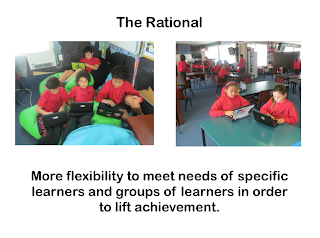This sounds like a dream situation doesn’t it? Something you might have in a Special Education class or a well resourced International School.
Well I work in such a classroom! I am lucky enough to be one of 3 experienced full time teachers in our class.
At this time of year with assessment, reports, prize giving items and end of year scratchiness I certainly appreciate the relief, the support, the jollying along and the flexibility this provides. In fact I can’t imagine how I managed Novembers pre Open Learning Space.
Last Thursday between morning tea and lunch, the whole class were creating brochures to inform and motivate next year’s Yr 6 Campers. This involved designing (pencil and paper), writing (google docs), drawing (sumo paint), illustrating (camp photos in picasa), displaying (google draw and spreadsheets), and publishing to print (pages and keynote). This took a fair bit of modelling, discussion, conferencing and feedback. But in typical fourth-termness there were a whole lot of other things going on as well.
Between the three of us we were also trying to complete the last GLOSS maths assessments, moderating some writing samples, re-connecting two angry parties that fell out over a morning tea game (kids not teachers!), taking a group of avid readers to the library to select and issue books, coordinating a group of choreographers to come up with suitable moves for our item, visiting other classes to collect data, connecting with family to check on sick week old baby at home, re-wiring sound system to be able to listen to the school news in 30 minutes, re-imaging netbooks, tracking down missing charger......
Every teacher has these goings on. The difference is I have 3 of me to cope.
Now I’m just wondering how I can get 4.
Well I work in such a classroom! I am lucky enough to be one of 3 experienced full time teachers in our class.
At this time of year with assessment, reports, prize giving items and end of year scratchiness I certainly appreciate the relief, the support, the jollying along and the flexibility this provides. In fact I can’t imagine how I managed Novembers pre Open Learning Space.
Last Thursday between morning tea and lunch, the whole class were creating brochures to inform and motivate next year’s Yr 6 Campers. This involved designing (pencil and paper), writing (google docs), drawing (sumo paint), illustrating (camp photos in picasa), displaying (google draw and spreadsheets), and publishing to print (pages and keynote). This took a fair bit of modelling, discussion, conferencing and feedback. But in typical fourth-termness there were a whole lot of other things going on as well.
Between the three of us we were also trying to complete the last GLOSS maths assessments, moderating some writing samples, re-connecting two angry parties that fell out over a morning tea game (kids not teachers!), taking a group of avid readers to the library to select and issue books, coordinating a group of choreographers to come up with suitable moves for our item, visiting other classes to collect data, connecting with family to check on sick week old baby at home, re-wiring sound system to be able to listen to the school news in 30 minutes, re-imaging netbooks, tracking down missing charger......
Every teacher has these goings on. The difference is I have 3 of me to cope.
Now I’m just wondering how I can get 4.















